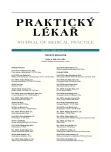Risky and harmful alcohol consumption in young adults: social and demographic context
Authors:
L. Csémy 1,2; H. Sovinová 1; B. Procházka 1
Authors‘ workplace:
Státní zdravotní ústav, Praha, Ředitelka: Ing. Jitka Sosnovcová
1; Psychiatrické centrum Praha, Ředitel: prof. MUDr. Cyril Höschl, DrSc.
2
Published in:
Prakt. Lék. 2011; 91(11): 656-661
Category:
Of different specialties
Overview
Objective:
The aim of this study is to determine the prevalence of risky or harmful consumption of alcohol among young adults in relation to demographic and social characteristics of the population.
Methods:
Analyses are based on a survey carried out on a representative sample of 2,221 persons (51.4 % male) aged 18 to 39 years (mean age 29.9 years, SD 5.8). Indicators of risky and harmful drinking were monitored through 8 social and demographic variables:
- gender,
- age,
- education,
- marital status,
- type of residence,
- economic activity,
- income, and
- socioeconomic status.
Results:
Risky doses of daily alcohol consumption were found in 26 % of men and 16 % of women. 11 % of respondents reported heavy episodic drinking on a weekly level, harmful drinking was reported by 12.5 % of men and by less than 3 % of women. The average daily consumption of alcohol for men was 29.5 g of alcohol and 10 g for women. Of the other variables, harmful drinking occurred more frequently in people with
- a low level of education,
- unemployed,
- in persons with lower socio-economic status and,
- in those divorced or not in a partner relationship.
Conclusion:
The results confirm that a significant proportion of young adults consume alcohol in a way that can lead to health harm. Better knowledge of social and demographic contexts can help in early identification of vulnerable individuals. From the perspective of primary health care, the most adequate preventative action is the method of brief intervention.
Key words:
alcohol, harmful drinking, health risks, socio-demographic factors.
Sources
1. Baan, R., Straif, K., Grosse, Y. et al. Carcinogenicity of alcoholic beverages. Lancet Oncology 2007, 8, p. 292-293.
2. Gmel, G., Rehm, J. Harmful alcohol use. Alcohol Res Health 2003, 27, p. 52-62.
3. Gutjahr, E., Gmel, G., Rehm, J. Relation between average alcohol consumption and disease: An overview. Eur. Addict. Res. 2001, 7, p. 117–127.
4. Kubička L., Csémy, L. Analýza sociodemografického kontextu požívání alkoholických nápojů v dospělé populaci České republiky z hlediska zdravotního. Čas. Lék. čes. 143, s. 435-439.
5. Rehm, J., Baliunas, D., Borges, G.L.G. et al. The relation between different dimensions of alcohol consumption and burden of disease – an overview. Addiction 2010, 105, p. 817-843.
6. Rehm, J., Taylor, B., Mohapatra, S. et al. Alcohol as a risk factor for liver cirrhosis – a systematic review and meta-analysis. Drug Alcohol Rev. 2010, 29, p. 437-445.
7. Rehm, J., Gmel, G., Sempos, T. C., Trevisan, M. Alcohol-related morbidity and mortality. Alcohol Res. Health 2003, 27, p. 39-51.
8. Ridolfo, B., Stevenson, C. The Quantification of Drug–Caused Mortality and Morbidity in Australia 1998. Canberra: Australian Institute of Health and Welfare, 2001. Dostupné na http://www.aihw.gov. au/publication-detail/?id=6442467226.
9. Room, R., Rehm, J. Alcohol and non-communicable disease-cancer, heart disease and more. Addiction 2011, 106, p. 1-2.
10. Sovinová, H., Csémy, L. The Czech AUDIT: internal consistency, latent structure and identification of risky alcohol consumption. Cent. Eur. J. Public. Health 2010, 18, p. 127-131.
11. WHO. Global strategy to reduce the harmful use of alcohol. Geneva: World Health Organisation, 2010. Dostupné na http://www.who.int/substance_abuse/activities/gsrhua/en/index.html.
12. WHO. International guide for monitoring alcohol consumption and related harm. Geneva: World Health Organisation, 2000. Dostupné na whqlibdoc.who.int/hq/2000/WHO_MSD_MSB_00.4.pdf.
13. WHO. Global status report on alcohol and health 2011. Geneva: World Health Organisation, 2011. Dostupné na http://www.who.int/substance_abuse/publications/global_alcohol_report/en/index.html.
Labels
General practitioner for children and adolescents General practitioner for adultsArticle was published in
General Practitioner

2011 Issue 11
Most read in this issue
- Faecal calprotectin
- Probiotics from the view of the general practitioner – clinical indications for the use of probiotics, results a questionnaire study among general practitioners
- Pulmonary embolism and its diagnostic problems
- Actinic keratosis: the facts about biological behaviour and clinico-pathological aspects of the disease from the view of pathologist
